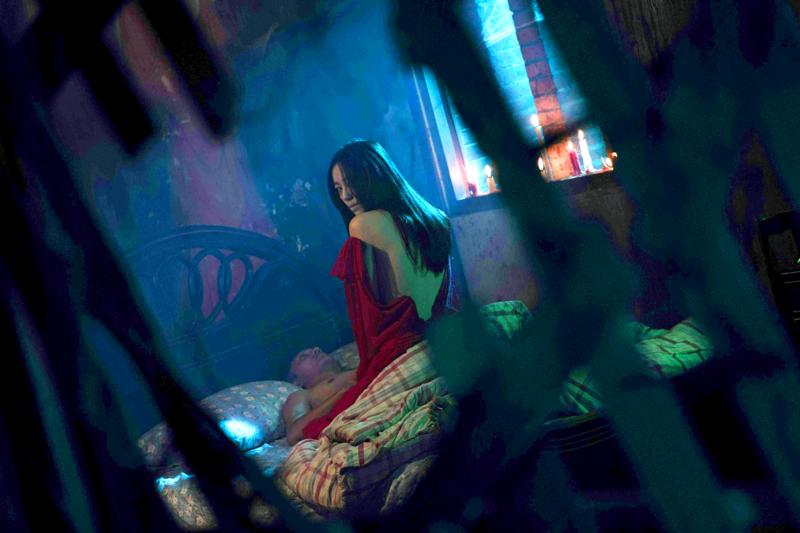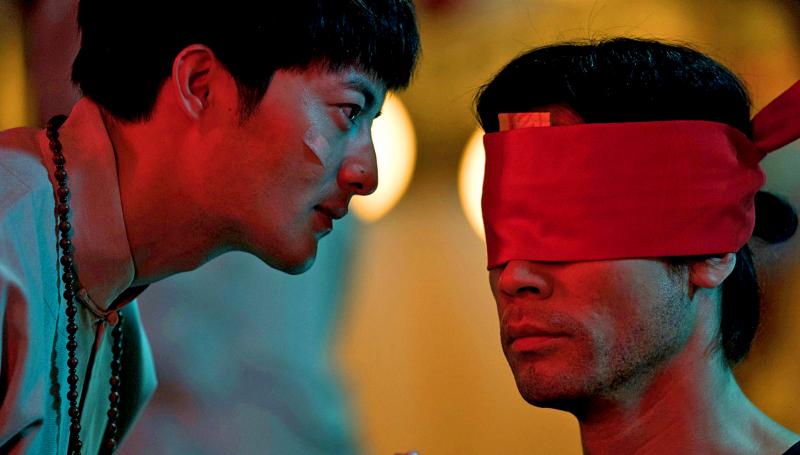It seems that even the filmmakers don’t know what happened in 49 Days (驚夢49天). After spending too much of the film building up the mystery and constantly introducing confusing elements, they wrap up the film in the last couple of minutes in the laziest way, with the protagonist actually uttering “nobody knows.” That is bloody annoying, having sat through over 90 minutes of disjointed and head-scratching storytelling.
Billed as a horror flick featuring the chilling Taoist ritual of guanluoyin (觀落陰), or visiting hell, 49 Days was meant to scare the pants off viewers over Dragon Boat Festival weekend. Horror movies don’t always need to make perfect sense, but 49 Days wasn’t frightening at all, even lacking a single good jump scare.
As a result, the film seems more like a drawn-out cop drama with supernatural elements. And the long-awaited guanluoyin ritual ends up mostly as a gimmick.

Photo courtesy of Creative Century Entertainment
The story revolves around successful executive Daniel (Lewis Liu, 劉國雄) whose life falls apart after having recurring nightmares of a woman in a red dress. After the first nightmare, the number 49 appears on his arm and counts down each day, representing the 49-day mourning period for the dead in Taiwanese culture. He soon becomes the prime suspect in a murder investigation, and his quest for the truth unearths secrets from his past. He’s aided by detective Yi-zhen (Lorene Jen, 任容萱), who also has her own trauma.
FOLK LEGENDS
Ever since The Tag-along (紅衣小女孩) became a sensation in 2015, almost every subsequent local horror production has involved Taiwanese folk legends and practices. The guanluoyin ritual is performed on people who want to visit a dead relative in the spirit world. While it does make sense to apply it to a murder mystery, the producers missed the opportunity to delve deeper into the fascinating yet harrowing ritual that many Taiwanese would be terrified to even consider trying.

Photo courtesy of Creative Century Entertainment
There’s little context and background, it’s just abruptly thrown in there as a way to revive Liu’s memories along with other forms of hypnotism. Likewise, the 49-day countdown that appears on Liu’s arm also seems to be a device to further the plot instead of holding any significance.
Nevertheless, there are a lot of promising ideas and elements in the film, even addressing sexual abuse of vulnerable young girls and women, and the storyline and settings are more ambitious than the standard Taiwanese horror flick. But that also means the filmmakers have more to explain and tie up. A lot of the storyline could have been cut out, as the pacing is bogged down by many unexplained details; it would have been better to use that time to flesh out the main plot.
Liu, who appears to be a Chinese actor based in the US, is an awkward fit for the role of protagonist Daniel. Touted as a Hollywood and Broadway veteran by the press, his only IMDb credit is this film, and little information can be found otherwise.
Liu’s background of someone who moved to the US as a youngster fits that of Daniel’s, but his Chinese accent and delivery in the film feels out of place, sounding almost like one of those Mandarin dubs for 1990s Hong Kong movies. It is even more inexplicable that the younger version of himself speaks Mandarin in a Taiwanese accent.
Technical details aside, Daniel is portrayed as a sullen, dark character even before the strange events begin, but Liu doesn’t exude enough charisma to pull off this type of anti-protagonist.
Jen has improved a lot since her pedestrian performance in last year’s Karma (玩命貼圖), playing the tortured but headstrong detective with conviction. But the two leads lack chemistry, and they just seem to be doing their own thing while occasionally converging despite sharing an emotional connection to the case. It’s extra disappointing because the ideas behind the film are very promising.
One final gripe: Taiwanese horror films need to get more creative with their ghosts. The long-haired woman wearing white or red gets old after a while.

Nov. 11 to Nov. 17 People may call Taipei a “living hell for pedestrians,” but back in the 1960s and 1970s, citizens were even discouraged from crossing major roads on foot. And there weren’t crosswalks or pedestrian signals at busy intersections. A 1978 editorial in the China Times (中國時報) reflected the government’s car-centric attitude: “Pedestrians too often risk their lives to compete with vehicles over road use instead of using an overpass. If they get hit by a car, who can they blame?” Taipei’s car traffic was growing exponentially during the 1960s, and along with it the frequency of accidents. The policy

What first caught my eye when I entered the 921 Earthquake Museum was a yellow band running at an angle across the floor toward a pile of exposed soil. This marks the line where, in the early morning hours of Sept. 21, 1999, a massive magnitude 7.3 earthquake raised the earth over two meters along one side of the Chelungpu Fault (車籠埔斷層). The museum’s first gallery, named after this fault, takes visitors on a journey along its length, from the spot right in front of them, where the uplift is visible in the exposed soil, all the way to the farthest

While Americans face the upcoming second Donald Trump presidency with bright optimism/existential dread in Taiwan there are also varying opinions on what the impact will be here. Regardless of what one thinks of Trump personally and his first administration, US-Taiwan relations blossomed. Relative to the previous Obama administration, arms sales rocketed from US$14 billion during Obama’s eight years to US$18 billion in four years under Trump. High-profile visits by administration officials, bipartisan Congressional delegations, more and higher-level government-to-government direct contacts were all increased under Trump, setting the stage and example for the Biden administration to follow. However, Trump administration secretary

The room glows vibrant pink, the floor flooded with hundreds of tiny pink marbles. As I approach the two chairs and a plush baroque sofa of matching fuchsia, what at first appears to be a scene of domestic bliss reveals itself to be anything but as gnarled metal nails and sharp spikes protrude from the cushions. An eerie cutout of a woman recoils into the armrest. This mixed-media installation captures generations of female anguish in Yun Suknam’s native South Korea, reflecting her observations and lived experience of the subjugated and serviceable housewife. The marbles are the mother’s sweat and tears,